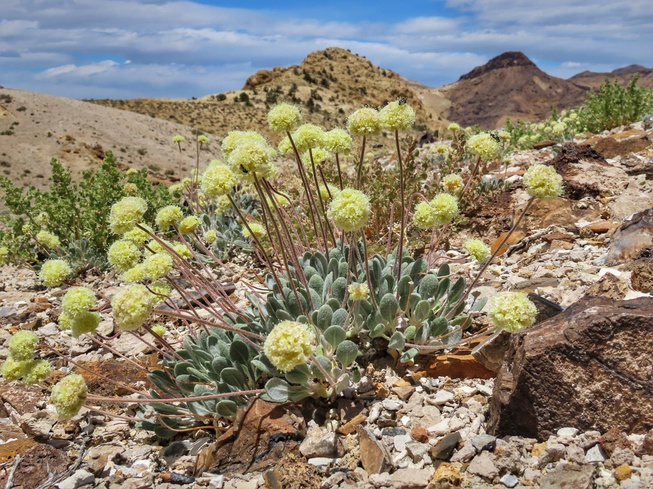
Patrick Donnelly / Center for Biological Diversity
Tiehm’s buckwheat (Eriogonum tiehmii), an already endangered wildflower, could have further harm caused by a proposed lithium mine in Esmeralda County, according to a Bureau of Land Management study released Tuesday, April 16, 2024.
Tuesday, April 16, 2024 | 7:13 p.m.
An endangered desert flower could lose more of its limited habitat to a proposed lithium mine near Rhyolite Ridge in Esmeralda County, according to a Bureau of Land Management draft environmental statement released Monday.
Tiehm’s buckwheat, a perennial with blue-grey leaves and yellow flowers, only grows on 10 acres of BLM land.
The U.S. Fish and Wildlife Service declared the plant endangered and designated a 910-acre critical habitat for it in 2022.
A 7,000-acre open pit lithium mine proposed by the Australian company Ioneer would damage either 38% or 22% of that habitat depending on the construction alternative selected, according to the DEIS.
Patrick Donnelly, Great Basin director for the Center for Biological Diversity, said the less destructive proposed alternative is “just greenwashing extinction.”
“Reducing the destruction of this rare plant's habitat from 38% to 22% is like cutting off one leg instead of both,” Donnelly said. “They’re still dealing a fatal blow to this precious, rare wildflower. This mine plan makes a mockery of the Endangered Species Act, and we’ll fight it with everything we've got."
The Center for Biological Diversity sued the U.S. Department of the Interior in 2021, after Ioneer’s exploratory mining damaged the plant’s scant natural habitat. The U.S. Fish and Wildlife Service named the drilling and development as the primary threat to the plant, followed by livestock grazing, invasive plant species, native animals feeding on the plants and climate change.
“The potential impact from the project proposed in the 2020 [plan of operation] would reduce the remaining Tiehm’s buckwheat population by 54 percent, or from 15,757 individuals to roughly 7,305 individuals, and remove 30 percent of its total habitat,” the service’s final rule stated.
Following the endangered designation, Ioneer submitted a new plan of operations to BLM in 2022 and funded a study on the plant later published in Ecosphere. The study found the plant played a key role for pollinators and spider species, and its unique soil requirements would make transplanting or growing in any other environment difficult.
“Our work did not identify any unoccupied sites within the broader range of E. tiehmii that were well-suited for growth across all life history stages,” the study states. “Therefore, conservation of E. tiehmii habitat is likely to be important for the long-term survival of the species.”
A public comment period on the draft will remain open until June 3.
